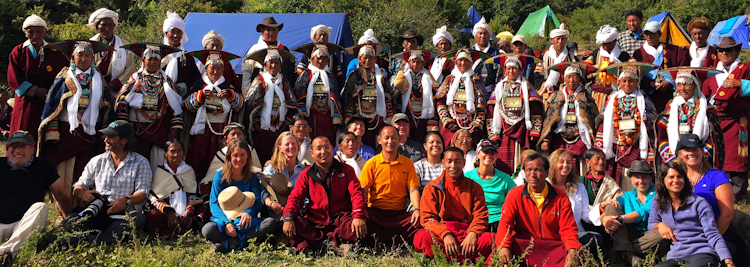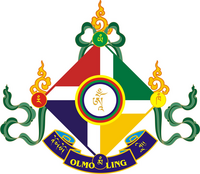The Olmo Ling Humla Project
Humla, Nepal | A Place of Vast Cultural and Natural Beauty
Click HERE for budget details or to support our work with a donation
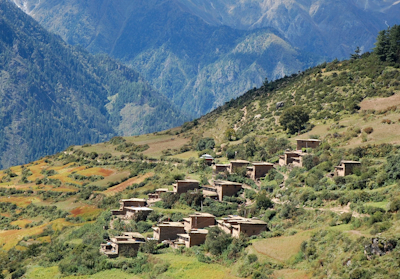
Torpa Village, Tempa Lama’s home village in Humla.
The Humla Valley, Tempa Lama’s home region, is a land of incredible natural beauty and rich cultural traditions. Tucked into the mountains in Nepal’s Northwest, the Humla district is one of the world’s most remote areas.
Humla is located in Karnali Province. It borders Tibet to the north in close proximity to the sacred sites of Mount Kailash and Lake Manasarovar. Many families in Humla have been deeply rooted in the Bon faith and Bon practice for many generations. Humla is also home to Tibetan Buddhist and Hindu practitioners and Shamanic lineages that continue today. Tempa Lama’s grandfather was a village shaman priest or Drang Rig. These shamans traditionally help villagers for health and prosperity.
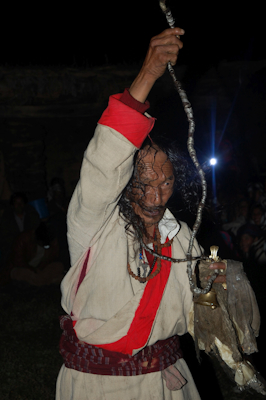
Shaman Pama, a Shaman Priest or
Drang Rig.
In the Bon tradition, Mount Kailash is viewed as the center of the universe – the soul mountain for the ancient kingdom of Zhang Zhung, where Bon originated. Mt. Kailash is the citadel of the celestial deity Gekhöd, the protector deity of Zhang Zhung. The area surrounding this sacred mountain is home to many Bon yogis and yoginis who live in long-term retreat. Nearby Lake Manasarovar is one of the most sacred lakes in Tibet, revered by Bon, Buddhist, and Hindu people alike. Stepping on the shore and taking a bath in the sacred Lake Manasarovar or drinking from its water is believed to purify the karma of a hundred lifetimes.
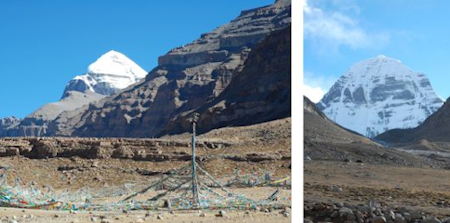
Mount Kaliash, Tibet
An Ancient Society in Transition
Humla’s approximately 50,000 inhabitants are spread out across many small villages in the lower, middle, and higher altitude parts of the valley. About 11,000 people live in the capital of Simikot. The traditional lifestyle is semi-nomadic around yak, sheep, and goat herding. The Humli people traditionally used sheep to carry salt on the Himalayan salt trading route with Nepal. During the short growing season, different varieties of millet, buckwheat, and barley and some vegetables are grown and stored for winter.
With Humla being so remote and lacking in resources, there is little access to medical care.
Most homes outside of Simikot do not have access to electricity or running water. The Humla valley can only be accessed on foot and via the small mountain airport that is visited weather-permitting by small aircraft from Nepalgunj. In recent years, tourism has grown in Humla, including by pilgrims that utilize the 5-6 day mountain trek to Mt. Kailash.
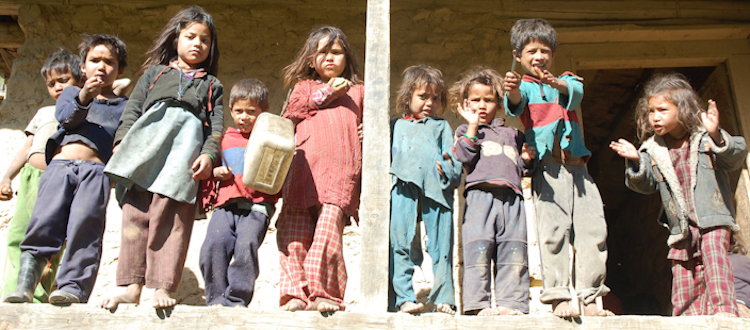
The Nepali government has established schools throughout its provinces, including in Humla. However, due to Humla’s remoteness, retaining good teachers long-term can be difficult. In addition, schools do not teach Tibetan language and culture. Today only about half of Humla’s population is able to read and write. Many families in Humla have now sold their livestock to support their children in leaving Humla for a better education and a new life in the city.
Creating a Sustainable Future for Humla
Tempa Lama has founded two organizations to support the Humli people during this transition. The Bon Cultural Society of Humla founded in 2001 in Humla is overseen by village elders. It is dedicated to better understanding needs and empowering villagers to address these needs and create their own future.
Humla Fund was originally established as an Olmo Ling project to oversee medical service trips to Humla and support children’s education. In 2014 it became a separate US nonprofit. With the help of the Humla Fund, Tempa Lama built five Shaman temples in different villages, one prayer wheel temple, and four stupas for protecting villages. From 2014 to 2018 Humla Fund offered annual medical service trips for hundreds of people in different villages.

Left: Shaman Temple, Right: Prayer Wheel Temple built by Tempa Lama and Humla Fund in 2014.
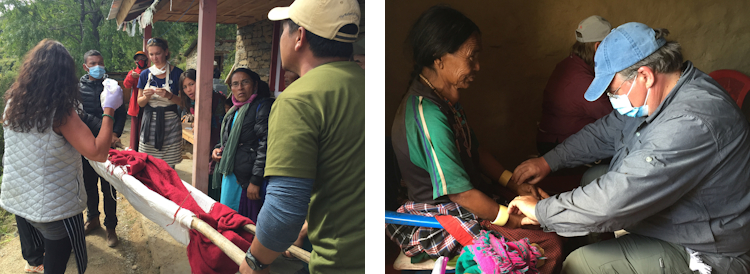
Annual Medical Trips made to Humla from 2014 – 2018. Bottom right: Tim Aitken, LAc. offering treatment
From 2017-2018 we built and equipped the traditional clinic Sorig Tenpe Menkhang outside Simikot. Sorig Tenpe Menkhang is staffed by a Tibetan doctor (Amchi) and Humla native Tsering Norbu Lama.
Amchi Tsering’s medical education was sponsored by Olmo Ling. The clinic is an initiative to preserve the native medical practice and to bring awareness of the importance of traditional practices to Humla’s youth. In 2022 the Karnali Province government recognized Sorig Tenpe Menkhang as an important center of Tibetan medicine. Read more about the clinic HERE.
In 2021 we raised $25,940 to provide urgently needed medical equipment to protect the people of Humla from the COVID pandemic. We were able to sponsor an oxygen concentrator, ventilators, hospital beds with monitors, oxygen masks, essential medicines, and protective equipment. Read more about this work HERE.
Humla Fund merged with Olmo Ling in December 2021 and is now our main charitable project. Olmo Ling is now responsible for Amchi Tsering’s monthly salary, clinic upkeep, and medical supplies. We are delighted to be overseeing this special project that carries so much benefit for the people of Humla.
Olmo Ling is also sponsoring children and supporting families to enable children to attend school. Children are typically either semi-orphans or from poor families. In addition, we have sponsored vocational training for several young Humli natives, including a radiologist, a carpenter, and a dentist.
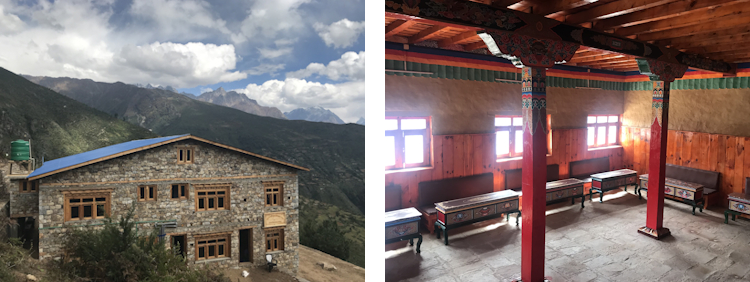
Sorig Tenpe Menkhang clinic, built by Humla Fund.
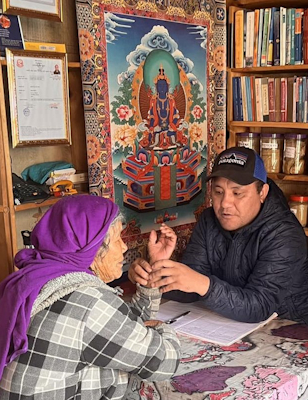
Tibetan Doctor Amchi Tsering seeing a patient.
Tempa Lama’s Vision for Humla Involves:
1. Broadening access to quality education and instruction in Tibetan language and culture in schools
2. Broadening access to traditional Tibetan and Western medicine and care and raising awareness of the importance of traditional medicine
3. Strengthening and preserving Humla’s traditional Bon culture, Bon and Shamanic heritage, and unique mountain ecology and
4. Identifying and supporting economic opportunities that can be part of a sustainable future for Humla.
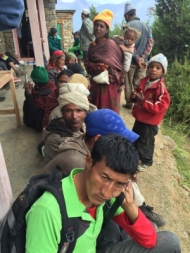
Villagers waiting to be treated.
Olmo Ling Humla Project 2023 Budget
We are very grateful to the tireless support and generosity of Doctor Tim Aitken and all the clinicians, volunteers, and donors of our work in Humla. We have so grateful that we have surpassed our budget for 2023. This will enable us to send Amchi Tsering’s first 2024 monthly salary payments shortly.
Budget details:Amchi (Tibetan Doctor) Salary for 2023: $6,500
Building Caretaker: $1,450
Maintenance & Repair: $1,300
Government and Audit Fees: $1,300
Medical supplies: $900
GRAND TOTAL: $11,450.00
We have now raised $13,026, surpassing our 2023 budget of $11,450!! All further donations will be used for 2024 expenses, including continuing to pay for our wonderful Amchi and essential medicines. Thank you so much for your generosity!!
Support our work in Humla!
Donate via PayPal or set up a recurring donation via Paypal
Please note that PayPal allows you to elect to either make a one-time donation or give monthly or annually
Donate via Check
Please write the check to Olmo Ling with a note “Humla Project” and send it to Olmo Ling, 1101 Greenfield Ave, Pittsburgh, PA 15217.
Donate via Credit Card
